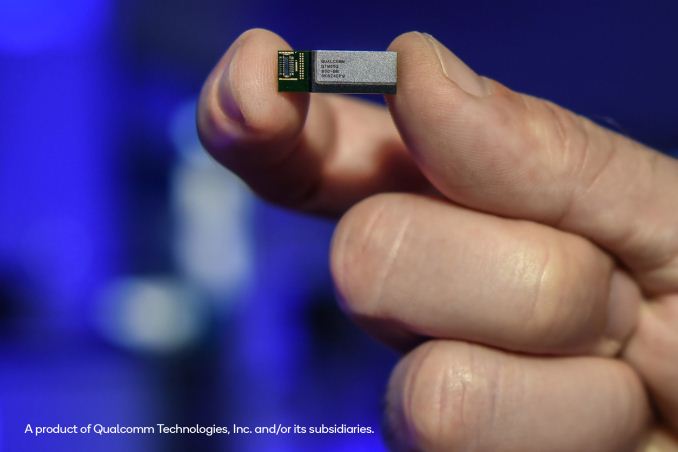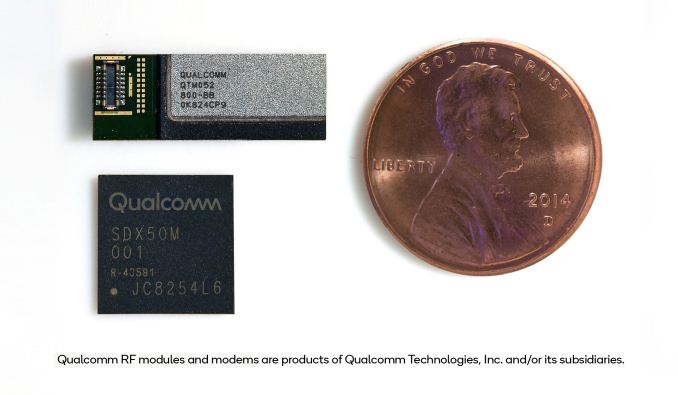Qualcomm Announces Their First 5G mmWave Antenna Module: QTM052, Coming This Year
by Ryan Smith on July 23, 2018 8:30 AM EST
For the past couple of years now, Qualcomm has been very publicly putting together the final pieces of the puzzle that are 5G cellular. The company announced their discrete 5G NR modem – the Snapdragon X50 – all the way back in 2016. Meanwhile in 2017 they demonstrated their reference phone design, which integrated the in-development X50 with a prototype millimeter wave (mmWave) antenna, allowing Qualcomm and its OEM customers to begin field testing the technology in a handheld form factor. Now in 2018 as the launch of 5G NR networks close in, the company is announcing the final version of their mmWave antenna module, the QTM052.
Although the antenna isn’t getting an especially memorable name, it’s one of the key components of the 5G hardware ecosystem Qualcomm is building, and one they’re understandably proud of. mmWave is a critical component of the 5G specification, as it’s going to be these high (and relatively unused) frequencies that are going to give 5G enough spectrum to hit its multi-gigabit target speeds. And while the more traditional the sub-6GHz spectrum of 5G will see some improvements as well, it’s a much smaller gain tempered by limited spectrum and decreasing spectral efficiency gains.
The QTM052 is a complete antenna module, integrating the necessary mmWave radio transceiver, RF front end, power management IC, and the phased antenna array necessary to send and receive signals. The module is exclusively for mmWave frequencies – so everything over 24GHz – while separate antennas and RF modules will handle sub-6GHz bands. Of those high frequencies, the module supports bands n257 (800Mhz spread through 26.5 to 29.5GHz), band n261 (27.5 to 28.35GHz) and band n260 (37 to 40GHz). And while not explicitly called out by Qualcomm, as our resident mobile guru Andrei Frumusanu has noted, those bands mean that this antenna module is primarily going to be used in the United States, as it doesn’t include band n258 (24.25 to 27.5GHz) which is one of the principal bands for Europe and China.
Unfortunately Qualcomm isn’t disclosing some of the technical details of the module – particularly the number of individual antennas that make up the array size – nor the physical size of the module. As far as the array size goes, we have a suspicion that it’s 8x8, but that remains to be seen. However the module’s physical dimensions are easier to take a stab at. Having thankfully included a penny in their stock photo that we can use as a size comparison, some quick paper napkin math puts the module at roughly 19mm x 7mm, and 2.9mm thick. So while the module is small, it’s not tiny. Which is an important distinction when adding up how many modules will be needed.
Altogether the X50 modem supports up to 4 mmWave modules, and while Qualcomm mentions this number in their press release as well, talking to Qualcomm’s representatives they believe we’re more likely to see just 3 in smartphones. This will be on top of the antennas and supporting equipment necessary for the sub-6GHz bands – and we’re not even counting 4G and WiFi radios – which is why there’s such an emphasis on size.
The use of multiple antenna modules, in turn, is all about getting around the basic limitations of mmWave’s frequency: poor signal propagation. 24GHz+ is part of what the ITU defines as the “extremely high frequency” band, and signals in this band are attenuated and absorbed by essentially everything. The atmosphere, the weather, the phone body, and especially human hands are all blockers here, and even when the signal isn’t blocked, it’s functionally line-of-sight. So having 3 separate antenna modules is necessary to ensure that a phone has a chance of achieving line-of-sight with a base station. Even then, the 5G standard relies on high-precision beam forming & steering in order to send signals in the right direction, which is why the modules internally use such a sizable array of antennas. And while Qualcomm’s press release talks up this point a bit too loftily – saying that it was “previously thought unattainable” – it’s none the less not an easy problem to solve. And even if the technology works, the LOS requirements mean that the market considerations for mmWave are very different from the traditional cell tower paradigm, as many smaller base stations are required for good coverage.
Meanwhile, tangential to today’s antenna module announcement, Qualcomm is also announcing their more conventional RF modules for sub-6GHz 5G, the QPM56xx RF module family. These will be paired with the mmWave module, providing the necessary “baseline” (and building-penetrating) 5G connectivity.
Finally, as these are Qualcomm’s commercial antenna modules, the company is already ramping up their production. OEM customers are being sampled now, with volume shipments set to begin in November/December. Potential network readiness aside, the company thinks that their OEM partners can have mobile broadband adapters on the market before the year is out. Otherwise 5G-enabled smartphones are expected to start hitting the market in the first half of 2019.
On which note, it’s worth reminding everyone that the X50 is a discrete, 5G-only modem. So any of the first-generation phones integrating 5G connectivity with Qualcomm’s solution will require this separate modem on top of whatever they use for 4G connectivity, meaning there will be power and size trade-offs made that we haven’t seen since the first generation of LTE phones.
Source: Qualcomm














20 Comments
View All Comments
Dragonstongue - Monday, July 23, 2018 - link
more radiation, higher cost, and likely to not have the ability to use it in most cities for all ^.^shabby - Monday, July 23, 2018 - link
I would like to see some power usage tests done on modems, these things are such power hogs that need to be scrutinized more.deil - Monday, July 23, 2018 - link
I wish any way of expanding the range on existing ones would exists. We have everything on USB. Why not expanded antenna for quality call in wildness.sing_electric - Monday, July 23, 2018 - link
Well, it does, kind of: Higher-frequency networks can theoretically deliver more bandwidth, but are also shorter range and more likely to be blocked by people/buildings/trees. (A rough, though imperfect analogy is that FM stations are higher-quality but shorter range than lower-frequency AM stations.)The past few years have seen a lot of carriers expand their lower-frequency offerings: Most 2/3G networks started in around ~800MHz.
700MHz rolled out a few years ago, and 600MHz is becoming more common - in the US, T-Mobile has invested a lot of money in 600MHz spectrum and bandwidth, though only a handful of devices (and no iPhones) support it at the moment. Those lower-frequency waves travel much farther than higher-frequency, and are more likely to make it through trees or buildings. The downside is that they have a limit on how fast they can be, which, on top of everything else, limits the number of users you can have on a given tower.
0ldman79 - Monday, July 23, 2018 - link
This has been much discussed in the WISP circles.The frequencies used have huge liabilities.
We can't even use similar bands on dedicated point to point shots with high gain antennas for any real distance. The bands are essentially useless unless you're almost literally within a stone's throw of the tower.
We're talking WIFI range, only if you turn the wrong direction your body will attenuate the signal.
I'm seriously interested to see the details of the tech, but you can't beat physics. The only way I see this working is if the various bands have massive reflections from concrete and wood. Even still I don't see any small to medium sized cities (like almost any in the state of Alabama) working with these bands at all.
My best guess is we're only going to see these bands in wide use in big cities and two or three tiny spots in medium sized cities. I'd be surprised if they even bothered to install the radios on towers in most places.
sing_electric - Monday, July 23, 2018 - link
When T-Mo and Sprint said "we need to merge or die for 5G," I'm sure part of it was just gamemanship, but the physics of mmWave means that installation heavily favors big players with deep pockets that can afford to install and maintain many, many towers.The physics of the signal also mean that the tech isn't even a good option for "Cells on Wheels" trucks that you see by large events, since the bodies of the crowd would likely block the signals.
I'm really wondering what the target use case is for these things - you need line of sight, which is difficult in dense urban environments (and indoors), proximity, which is difficult in non-urban environments. Maybe the plan is to mesh mini-cell sites together, so you don't have to install infrastructure at every spot? Of course, then you're cutting down on available bandwidth, and it really seems like even moderate rain would be enough to make these signals unworkable...
p1esk - Monday, July 23, 2018 - link
Exactly my thoughts. I need cell tech that would provide connectivity in places where my 3G/4G signal fails. 20GHz+ does not seem like a solution to that problem. 200MHz ranges would probably be, even if only good to send a text.MrSpadge - Tuesday, July 24, 2018 - link
With modern audio compression I could imagine we can get away with a few 100 MHz below 800 MHz and still have enough bandwidth for calls.iwod - Monday, July 23, 2018 - link
I wonder what sort of die size will for Modem will it be.iwod - Monday, July 23, 2018 - link
I mean the combined 4G and 5G modem. The 5G modem X50 alone is quite big, is a 7nm die shrink enough for it to be fitted inside phone. At what cost?